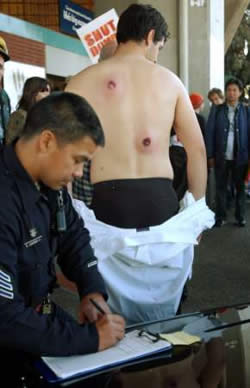|
OAKLAND --
Amid legal concerns that Oakland police should not have fired
"less-than-lethal" munitions at anti-war protesters earlier this year,
the Citizens Police Review Board has postponed making recommendations
on a plan to revise police procedures.
After a five-hour
hearing Thursday night at City Hall, Police Review Board members were
poised to comment officially on Oakland Police Chief Richard Word's
proposal this week to limit or eliminate the use of less-than-lethal
weapons such as wooden dowels, bean bags and stinger grenades.

A protestor, who refused to give her name, bears the wounds after she
says was hit by Oakland police weapon during a anti-war protest in
Oakland, Calif., Monday, April 7, 2003 outside the port area. (Paul
Sakuma)

Berkeley resident Clay Hinson (R), who was shot once in
the chest and twice in the back during an anti-war protest, shows his
wounds to an Oakland Police sergeant (L) who takes his statement at the
West Oakland train station, April 7, 2003. Oakland police fired rubber
bullets and wooden pellets on Monday to disperse hundreds of anti-war
protesters in what was believed to be their first such use against U.S.
protesters since the American-led war on Iraq began. REUTERS/Tim
Wimborne
|
But after repeated concerns raised by protesters and the police
review panel's own legal counsel, Anthony Lawson, a private Oakland
attorney, the panel put off the issue.
The six-member panel
instead unanimously agreed to organize a committee of top police
officials, peace activists, legal experts and Police Review Board
members and staff for further study. Lawson
contended that legal
precedent in police brutality cases raised doubts as to whether police
can fire less-than-lethal weapons at protesters in an effort to break
up large demonstrations.
"You can't really do
that," Lawson said. "To use less-than-lethal weapons for crowd control,
you're going to create a liability problem" for the city.
Less-than-lethal
weapons can seriously injure, or kill. As a result, courts have ruled
that police officers should only use such weapons if there is an
immediate threat to the safety of officers or others, Lawson said. Controversial demonstration
During an April 7
demonstration against the war in Iraq, Oakland police shot wooden
dowels and bean bags and hurled stinger grenades at protesters,
injuring 41, including bystanders, according to a report by the review
panel's staff. Many of the demonstrators were hit in the back as they
tried to get away.
The melee made
national news. Two dozen protesters were arrested and are facing
misdemeanor charges. Protesters and members of the International
Longshoremen Worker's Union sued the police department and the city in
federal court.
Word has repeatedly
defended his officers' actions, echoing their allegations that
protesters threw projectiles and that police ordered demonstrators to
disperse more than once before opening fire. Word said Thursday police
have videotape evidence and collected a few of the projectiles.
Such evidence, however, has not been made public.
Protesters deny the
police allegations, saying they were demonstrating peacefully,
exercising their First Amendment rights. Police overreacted and should
not have attempted to disperse them, they argued.
In addition, there
is no evidence the protesters presented an immediate threat to police
or anyone else when police fired at them.
"You need to be
discussing police control, not crowd control," Jack Heyman, an agent
for the longshoremen's union, told the police review panel. "What
police did on April 7 was an atrocity." More training proposed
Jerry Harper, a
longtime top official in the Los Angeles Sheriff's Department and
former director of the California Youth Authority, told the review
panel that police departments must focus more on training when dealing
with demonstrators.
In a response to a
question by panel member Susan Raffanti, he also said the most
effective way to disperse peaceful protesters is for officers to form a
skirmish line, issue a dispersal order repeatedly and move toward the
protesters. If the protesters do not leave, police should push the
crowd with their batons and then arrest protesters if they still don't
disperse, Harper said.
Earlier this week,
Word announced that after an internal review his department would ban
the use of wooden dowels and would no longer bump protesters with
police motorcycles. During the meeting, he also said his department
would suspend the use of stinger grenades. But he said his department
would keep in its arsenal bean bags shot from rifles, known as
"flexible batons."
Lawson said later
the emphasis on what weapons should remain on the department's list
represents "a disconnect" from the more pressing issue of the
appropriate use of force against protesters.
"The underlying
question is not what should be discontinued by the department," Lawson
said. "The underlying issue is whether it was reasonable to use force."
Word also vowed to
attempt to meet with protest leaders before planned demonstrations.
Such meetings occurred prior to protests on April 5 and May 12, and
they went off without incident.
©1999-2003 by MediaNews Group, Inc. and ANG Newspapers
###
|

